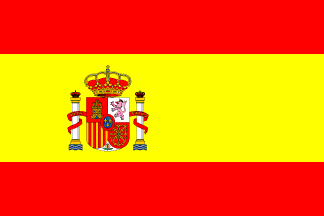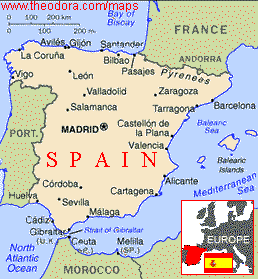 Alicante - Spain
Alicante - Spain Alicante - Spain
Alicante - SpainAugust 2017
As soon as we returned from the Dordogne, Wendy was keen to fit in another short trip before she went back to teachingl. I found a cheapie package of flight and apartment to Alicante, Spain leaving from London Gatwick early on Sunday August 27th, returning on Friday September 1st
At Alicante airport, I picked up our car rental. Our apartment was in the ‘Alicante Hills’ complex. It was apparently only 15 minutes drive from the airport but we completely missed it and drove in and around Alicante for about an hour before locals directed us to a turn off up a hill to a hidden complex. There were no signs from the road. Doh!
We had a spacious two bedroom, two bathroom apartment with a well equipped kitchen, lounge and balcony. There was a swimming pool and small spa pool, a restaurant/bar and small shop. Our room was not ready when we arrived so we had an excellent pizza and cold beer while waiting. For the next few days, we toured locally around the provinces of Valencia and Murcia and generally had a relaxing time. I had flown here in December 2004 for a one week road trip flying home on Xmas Day.
Alicante itself was a city of around 330,000 people on the Costa Brava. The Lonely Persons Guide called it a “dynamic, attractive provincial town”. Until the 2008 global recession, it was one of the fastest-growing cities in Spain. It was a pleasant enough place with the Santa Barbara castle on Mount Benacantil overlooking the city. Downtown by the sea was the Explanada de Espana lined with palm trees and paved with over 6 million marble floor tiles laid out in a wavy pattern. Not a lot of people know that Alicante is twinned with Nice, France, Carloforte, Italy, Herzliya, Israel, Leon, Nicaragua, Matanzas, Cuba, Oran, Algeria, Riga, Latvia, Toyooka, Japan, Wenzhou, China and Sivas, Turkey. Phew!
On our first day, we drove north past the tower blocks of Benedorm and into the mountains heading for Guadalest. The drive inland from Altea followed a winding road ever higher past the picturesque village of Polop. En route, we found an off road local restaurant with views over the pine trees, citrus groves and almond trees orchards which filled the valley. We ordered a range of tapas and a bottle of red wine and enjoyed the solitude.
El Castell de Guadalest, the 'Eagle's Nest', is located about 25 km inland from Benidorm along the CV-70 road, just over 1 hour from Alicante. It enjoys one of the most spectacular locations of any village in Spain, set high up on a pinnacle and carved out of a mountain top in the midst of truly stunning scenery. It was originally only accessible using donkeys. It has a population of only 200 but is one of the most popular tourist attractions in Spain apparently dealing with over two million visitors a year.
Surrounded by the Aitana, Serella & Xorta Mountains this village of Islamic origin was a strategic military stronghold of great strategic importance and is the site of several ancient castles. Two of its most famous landmarks are the Peñon de La Alcalá tower and the Castillo de Sn Jose, both rising high above the village to watch over the valley below. The village itself is really just a pleasant tourist trap for day trips from Benedorm with shops, craft shops, museums and restaurants. While it looked intriguing, we passed on the Museum of Salt and Pepper shakers, holding a private collection of about 20,000 salt and pepper cellars from around the world.
From Guadalest we spotted the spectacular reservoir below the town which was created by damming the River Guadalest. Driving down through the narrow alleyways of a neighbouring village, we found a single track lane around the reservoir and took in the views.
The following day, we headed south into the province of Murcia to visit Cartegena. We used a toll road to quickly cover the distance since it was raining heavily. Thankfully it had stopped by the time we arrived for another tapas lunch and enormous glasses of sangria.
Cartagena is a port city and naval base which was founded by the Carthaginians around 220 B.C., and then expanded during the Roman period. Among its many Roman ruins are a 1st-century B.C. Theatre and Casa de la Fortuna, a villa with murals and mosaics. Wandering downtown which was full of cruise ship passengers, we reached the Plaza de Ayuntamiento where there was an entrance to the Roman Theatre Museum. Originally buried for centuries, the layers are now slowly being peeled back.
Quoting from the ‘Lonely Persons Guide’:“The city’s latest museum was designed by the prize winning architect Rafael Moneo. The tour transports visitors via escalators and an underground passage beneath the ruined cathedral to the magnificent, recently restored Roman theatre.... The tour and layout of the museum is designed to reflect Cartagena’s fascinating layers of urban history and includes Roman statues and artefacts, excavated from the site, as well as the cathedral’s crypt and remains of an original Moorish dwelling.” Some of the stones were obviously used to build houses in the past, but the basic shape, seating and the remains of the stage are visible.
On our third day, we headed north up the toll road to Valencia about 90 minutes away. It is Spain’s third largest city (810,000 pop) and known for its aesthetically stunning ‘Ciudad De Las Artes y Las Ciencias’ or ‘City of Arts and Sciences, with futuristic structures including a planetarium, an oceanarium and an interactive museum. The complex occupies a massive 350,000 sq metre swath of the old Turia riverbed and is the work of local architect Santiago Calatrava.
There is a lot to do in Valencia and this was just our first visit. We had come to experience the ‘Oceanographic’ a very popular attraction (I lined up for 45 minutes to get entry tickets) that invited us to travel around the planet’s main seas and oceans. There were more than 45,000 examples of 500 different marine species divided between 10 main areas. The marine areas reflect the Mediterranean habitats, the polar oceans - the Arctic and the Antarctic, the islands, the tropical seas, the temperate seas and the Red Sea. It also had a spectacular dolphinarium. There were nine underwater towers, structured in two levels and where we found sharks, Beluga whales, walruses, Patagonian sea lions, Humboldt penguins and manta rays. There was also an large aviary, butterfly farm and various outside pools. One of the highlights were a couple of underwater tunnels, one 70m long where you walked underneath marine life on all sides.
Late in the afternoon, we entered the dolphinarium of the Oceanography, which, with a total of five pools, is the largest of its kind in Europe seating 2200 people and containing 23 million litres of water. We watched an entertaining 30 minute show of a dozen magnificent dolphins displaying their abilities and intelligence. The sight of them rising vertically out of the water to do a double somersault was very impressive. We spent 6 hours in this magnificent complex. It was something that I would not normally do, but Wendy really enjoyed seeing the marine life, much of which I would see when scuba diving. Recommended (but if you know what day you want to visit, get your tickets on line in advance).
On our last day, we pottered along the coast for a quick (very quick) look at Benedorm where so many British tourists go for their holidays and then headed into the hills again for a mystery tour. We found a town with restaurants doing late lunches and ordered more tapas. We were spoiling ourselves on this trip, eating lunches as opposed to packed lunches and using the evenings to snack.It had been a very quick break concentrating on a small area of Spain. Valencia will need another visit to take in the modern architecture but it been nice to get away again.
